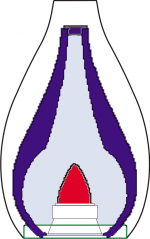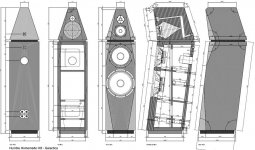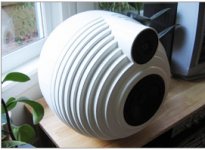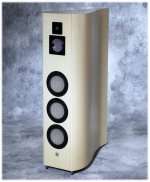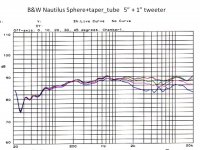The best shape for a speaker container would be a sphere, which is difficult to be easily reproduced by a diyer, but with new technology it can be simply done. Make a cubical shape container, example 4 x 4 x 4, buy a 4 inch rubber ball that can be deflated. Spray the rubber ball with cooking oil all over insert the inflated ball that snuggly fits in the cube. Clamp a temporary baffle that has two holes drilled in opposite corners and spray the side that is facing the open part where the ball is located. Clamp the temporary baffle down and the spray in the neat part of this the self sealing insulating foam sold at hardware stores. Following direction for the amount of time needed to let it set and harden. Later remove temporary baffle, deflate the ball and remove. No more standing waves and better response.
The best shape for a speaker container would be a sphere, which is difficult to be easily reproduced by a diyer, but with new technology it can be simply done. Make a cubical shape container, example 4 x 4 x 4, buy a 4 inch rubber ball that can be deflated. Spray the rubber ball with cooking oil all over insert the inflated ball that snuggly fits in the cube. Clamp a temporary baffle that has two holes drilled in opposite corners and spray the side that is facing the open part where the ball is located. Clamp the temporary baffle down and the spray in the neat part of this the self sealing insulating foam sold at hardware stores. Following direction for the amount of time needed to let it set and harden. Later remove temporary baffle, deflate the ball and remove. No more standing waves and better response.
REDUCE standing waves???? reduce to one frequency in ALL directions maybe but not reduce them in amplitude--IMHO BAD BAD idea
The best shape for a speaker container would be a sphere, ...
I think B&W research on spherical enclosures with tapered tube rear wave absorption is one of the best midrange and tweeter designs. The B&W website has technical information and measurements.
A friend took large styrofoam shapes - sphere + cone - cut them to mimic the B&W shape, sealed them with primer paint, and hand coated this shape with sand-only cement plus fiberglass string mat. When it had hardened he used acetone to melt away the styrofoam. The midrange sound was excellent.
Tony Gee produced a similar shape in his Galactica speaker by stacking MDF cut outs.
The Lumen White Light speaker uses a bulge+taper in a more traditional cabinet claiming it removes the reqirement for (any? most?) stuffing
Attachments
I think B&W research on spherical enclosures with tapered tube rear wave absorption is one of the best midrange and tweeter designs. The B&W website has technical information and measurements.
A friend took large styrofoam shapes - sphere + cone - cut them to mimic the B&W shape, sealed them with primer paint, and hand coated this shape with sand-only cement plus fiberglass string mat. When it had hardened he used acetone to melt away the styrofoam. The midrange sound was excellent.
Tony Gee produced a similar shape in his Galactica speaker by stacking MDF cut outs.
The Lumen White Light speaker uses a bulge+taper in a more traditional cabinet claiming it removes the reqirement for (any? most?) stuffing
Hi,
Do you have a link to the measurements on the B&W website? I cant seem to find them.
Much appreciated,
Matt
Standing waves just don't work the way most people think they do.
At frequencies where the wavelength is on par with or shorter than the dimensions of the enclosure things tend to *more like* light bouncing off mirrors, but not really. Sound spreads, it's a wave. Especially when it meets a finite barrier.
The B&W nautilus designs are for the most part an acoustic labyrinth that has been coiled. So for waves that travel back from the driver, it works... waves that travel perpendicular to that plane, it's not quite as wonderful, except to the extent that the "back wall" appears to be nearly infinite.
Round walls are reflectors that focus energy back... so the effects and the problems are different, the pattern of nodes inside the enclosure is different, more so as frequencies go higher.
People have tried the "egg" shape too...
Just about every shape has been tried. There is so far, no magic shape.
_-_-bear
At frequencies where the wavelength is on par with or shorter than the dimensions of the enclosure things tend to *more like* light bouncing off mirrors, but not really. Sound spreads, it's a wave. Especially when it meets a finite barrier.
The B&W nautilus designs are for the most part an acoustic labyrinth that has been coiled. So for waves that travel back from the driver, it works... waves that travel perpendicular to that plane, it's not quite as wonderful, except to the extent that the "back wall" appears to be nearly infinite.
Round walls are reflectors that focus energy back... so the effects and the problems are different, the pattern of nodes inside the enclosure is different, more so as frequencies go higher.
People have tried the "egg" shape too...
Just about every shape has been tried. There is so far, no magic shape.
_-_-bear
The best shape for a speaker container would be a sphere, which is difficult to be easily reproduced by a diyer, but with new technology it can be simply done. Make a cubical shape container, example 4 x 4 x 4, buy a 4 inch rubber ball that can be deflated. Spray the rubber ball with cooking oil all over insert the inflated ball that snuggly fits in the cube. Clamp a temporary baffle that has two holes drilled in opposite corners and spray the side that is facing the open part where the ball is located. Clamp the temporary baffle down and the spray in the neat part of this the self sealing insulating foam sold at hardware stores. Following direction for the amount of time needed to let it set and harden. Later remove temporary baffle, deflate the ball and remove. No more standing waves and better response.
I'm afraid that as I understand your idea it would not be so good as you think. The spherical shape is a somewhat good shape for the outside of the speaker to reduce diffraction. But it is the worst possible shape for inside the cabinet since the design reinforces all the standing waves at one frequency. It sounds like, from your description, if I understand it, that the sphere would be inside the cubic shape. And would make up most of the internal volume of the speaker. If this is the case it would indeed be bad.
But you could' I suppose, make some kind of a small sphere inside a speaker cabinet that was not used for air volume that could bounce and break-up the waves inside the cabinet. You would however, need to increase the size of the cabinet to make up for the lost space.
Hezz
Hi,
Do you have a link to the measurements on the B&W website? I cant seem to find them.
Much appreciated,
Matt
B&W has a few white papers on the development of the Nautilus 801 speaker which include measurements for the midrange and tweeter sphere+taper_tube.
Some of the white papers have been mirror'ed.
http://www.hifiportal.co.uk/Articles/Article0026-Development of the Nautilus 801.pdf
Nautilus | technologies - Bowers & Wilkins | B&W Speakers
Attachments
Hello, I just done same thing, still before finishing the enclosure, work not permitting any job done. But tomorrow is my last day abroad  i just filed resingment.
i just filed resingment.
So between the holidays i might get the mfinished. You can find my build on the full range forum as I use Fostex 168 Sigmas as drivers.
As they are now, I made the best possible copy of B&W shape. Teardrop on the outside with the inside a sphere with cut of back and prolonged to a funnel with exhaust (insert better description here....)
Anyway, before completing, I make a lot of pics and update the forum post so you can have a look.
I can tell you from initial listening, the sound is impressive. I had a guy over from recording studio, and he was impressed by the clarity of midrange. However they where still not finished, I suspect a little better results when done so.
Anyway, I am more then willing to share construction details.
Fingers crossed to your project. But please consider different aproach to construction as you mentioned. Seems too complicated. Keep it simple and sturdy. Plan well ahead.
Danny
So between the holidays i might get the mfinished. You can find my build on the full range forum as I use Fostex 168 Sigmas as drivers.
As they are now, I made the best possible copy of B&W shape. Teardrop on the outside with the inside a sphere with cut of back and prolonged to a funnel with exhaust (insert better description here....)
Anyway, before completing, I make a lot of pics and update the forum post so you can have a look.
I can tell you from initial listening, the sound is impressive. I had a guy over from recording studio, and he was impressed by the clarity of midrange. However they where still not finished, I suspect a little better results when done so.
Anyway, I am more then willing to share construction details.
Fingers crossed to your project. But please consider different aproach to construction as you mentioned. Seems too complicated. Keep it simple and sturdy. Plan well ahead.
Danny
REDUCE standing waves???? reduce to one frequency in ALL directions maybe but not reduce them in amplitude--IMHO BAD BAD idea
One trick everybody seem to miss is that for a sphere, the standing waves due to paralel walls all move through one point- the centre point of the cube. This is easy to break up by simply running a brace through that point (rectangular, not round). Then the sphere becomes a very good shape, IMHO.
Enjoy,
Deon
Last edited:
This would be true if the driver were in the center of the sphere, but would it still be true with the driver on the perimeter?REDUCE standing waves???? reduce to one frequency in ALL directions maybe but not reduce them in amplitude--IMHO BAD BAD idea
This would be true if the driver were in the center of the sphere, but would it still be true with the driver on the perimeter?
No, standing waves are set up between two parallel sides. A square box has 6 flat parallel sides, therefore 3 pairs of parallel sides, all of them the same distance from each other, so all standing waves will be at the same frequency. A rectangular box also has 6 parallel sides, but they vary with respect to distance from each other, hence the standing waves will be at different frequencies. A ball has infinite parallel sides, but they are all through the central point of the ball. The point where the frequencies are generated is not of importance.
Deon
the *volume* of the enclosure sets up a standing wave condition alone.
If it was as simple as making a sphere and putting something in the middle, anechoic chambers would be made this way. And, the dome or sphere would be a more popular shape for buildings.
In fact domed large auditoriums and arenas have proven to be very problematic acoustically...
if there are parallel sides it is true that at high frequencies (where the wavelength is shorter than the distance between walls, that standing waves that are a function of the wavelength can be set up and reinforced.
But you can take a large bowl (half sphere) and perturb the liquid and observe that standing waves still occur - compare to the square or rectangular container... water can be used for fill, you can put a speaker against a side and sweep the freqs... even putting the back end of the speaker against the side probably will be sufficient, etc...
I'll bet that if you put something in the middle of the water the effect will be approximately the same for the bowl as the other shapes...
what will vary is the amplitude at any given frequency depending on the distances... as in cube vs. rectangular solid shape vs. sphere vs. egg vs. pyramid vs. truncated pyramid, etc...
so, at LF it makes no difference really, and at higher freqs you still need absorption to limit the internal reflections and so the resonances... that's where I'd put the focus - on absorbing unwanted energy.
Proper and effective internal absorption will outperform any shape variation by orders of magnitude.
External shape however is a major factor in how the sound is radiated and if there is diffraction or not - flatness of frequency response...
_-_-bear
If it was as simple as making a sphere and putting something in the middle, anechoic chambers would be made this way. And, the dome or sphere would be a more popular shape for buildings.
In fact domed large auditoriums and arenas have proven to be very problematic acoustically...
if there are parallel sides it is true that at high frequencies (where the wavelength is shorter than the distance between walls, that standing waves that are a function of the wavelength can be set up and reinforced.
But you can take a large bowl (half sphere) and perturb the liquid and observe that standing waves still occur - compare to the square or rectangular container... water can be used for fill, you can put a speaker against a side and sweep the freqs... even putting the back end of the speaker against the side probably will be sufficient, etc...
I'll bet that if you put something in the middle of the water the effect will be approximately the same for the bowl as the other shapes...
what will vary is the amplitude at any given frequency depending on the distances... as in cube vs. rectangular solid shape vs. sphere vs. egg vs. pyramid vs. truncated pyramid, etc...
so, at LF it makes no difference really, and at higher freqs you still need absorption to limit the internal reflections and so the resonances... that's where I'd put the focus - on absorbing unwanted energy.
Proper and effective internal absorption will outperform any shape variation by orders of magnitude.
External shape however is a major factor in how the sound is radiated and if there is diffraction or not - flatness of frequency response...
_-_-bear
No, standing waves are set up between two parallel sides.
Deon
Just a few thoughts to add:
Parallel standing waves between parallel surfaces is just one very simple and common kind of phase reinforcement and cancellation...just one of many. But it is hardly the only kind of problematic stationary or moving reinforcement or cancellation. For instance in cabinets or rooms there are often significant more complex modes where sound bounces at an angle off the floor, a wall, the ceiling, the opposite wall, back to the floor; that will also reinforce or cancel at some frequency (sometimes called a 'circular' standing mode though obviously not really round). Imagine the ways a superball in weightlessness could bounce inside and reach its original position repeatedly. And of course there are more complex bounces that can reinforce or cancel, like floor / ceiling / wall / floor / other wall / floor. The incident angles may make it travel thru more absorptive material and the additional surfaces encountered may further dampen these modes, but they can still be significant. Imagine a laserpointer inside a reflective ball; as you change the incident angle you get different problematic reinforcing geometries...you get direct return, a triangle, a square, a pentagon, a hexagon, etc. etc.
Ideally the volume and stuffing inside the box is supposed to absorb all the sound. In reality, when stuffed, what calcuates to be a reinforcement might actually be a very powerful absorptive trap tuned a bit lower, due to the stuffing.
I dont even remember posting that which you quoted...offsetting the driver may mitigate the standing wave influence on cone movement which would be worst if the cone intersects the antinode of a particular standing wave. Harmonics however present a further issue, where the driver cant physically be placed to avoid antinodes over the harmonic waves and the fundamental. Not to mention that offsetting within a sphere would also be problematic and compromised at best. I suppose a sphere of say 4 times the driver diameter could be placed on the floor, then an offset applied so the driver points up to the listener, but ive not seen a single example of such a design. If the sphere is less than twice the driver diameter, it would be nigh on impossible. Offsetting would merely offset the excittation of the membrane by the standing wave fundamental and harms. Like what occurs in a tube, changing driver position along the tubes length.This would be true if the driver were in the center of the sphere, but would it still be true with the driver on the perimeter?
Last edited:
how about a hemisphere?
id imagine a hemisphere wouldnt be great either. Id guess it would act as a parabolic mic does, and create a focal point. However sound isnt quite as simple as ray tracing, but quite where it departs from ray tracing to pressure driven i am unsure. That is beyond my humble experience.
A hemi with a heavily damped tline placed at the apex 'sinking' the rear wave could work very well. I.e. Nautilus '
Last edited:
You need volume, but you don't want standing waves. Two approaches are
- No walls at all, open baffle.
- No open volume at all = this one could be seen in anechotic rooms. Take it to extreme, and enjoy. Whoa? Pyramids on all the walls, larger than lowest frequency you'll play in there. Another way to say is to sectionize the volume in such way so the sections will be smaller than the wave itself.
- No walls at all, open baffle.
- No open volume at all = this one could be seen in anechotic rooms. Take it to extreme, and enjoy. Whoa? Pyramids on all the walls, larger than lowest frequency you'll play in there. Another way to say is to sectionize the volume in such way so the sections will be smaller than the wave itself.
- Status
- This old topic is closed. If you want to reopen this topic, contact a moderator using the "Report Post" button.
- Home
- Loudspeakers
- Multi-Way
- My sphere in cube idea for reducing standing waves
